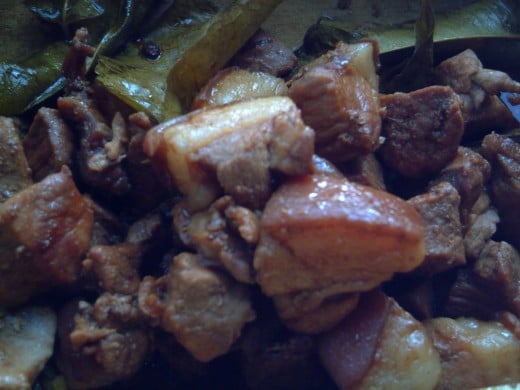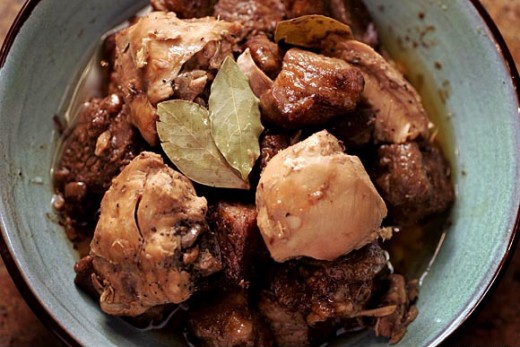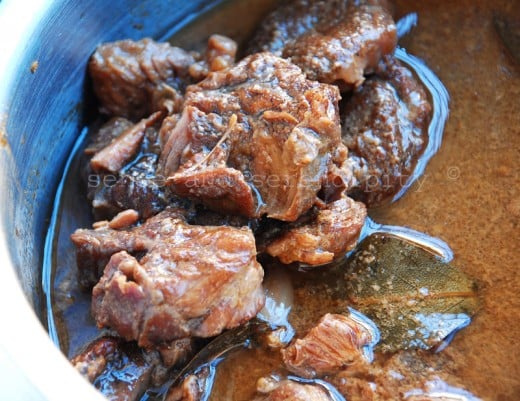The Famous Pork 'Adobo'
Pork Adobo: One of Philippine Cuisine's Best





June 17 (Thursday) Main Dish & Side Dish Recipes
I’ve been thinking about it for a long time. I don’t think it will be considered as regional dish. I’m talking about adobo - the Philippine famous pork dish, beside lechon (roasted pig). Because of many Filipinos working and living overseas, and some of them are owners of fastfood-restaurants in other countries, this main dish of the Filipinos is the well-known food among others. Every region has its own version of this dish. Some have extenders (mostly vegetables or verduras) that can serve as side dishes.
When the Spaniards came to the Philippines in 1521 (headed by Portuguese explorer Fernando Magallanes), the natives offered them a sumptuous feast of dishes, featuring native wild boar (usually dark in color) which was usually roasted during that time. These European invaders contributed to the development of the distinct Filipino cuisine that is becoming popular around the world. That’s why we have embutido , menudo, kare-kare which have distinct Spanish influence.
Even when I, Travel Man, went onboard a merchant vessel starting 2001, the Greek officers used to crave for adobo that I used to include in the menu of the crew, that were mostly Filipinos. Even they’re afraid of the cholesterol of the pork’s fatty parts, they still eat it because it is so good to the taste. My chief Greek cook, who’s a diabetic person, always ready his medicines after eating it. So, why not introduce it to my fellow hubbers, all are gourmets, who want to taste an authentic Philippine food? Too bad, I’ll not serve it for you personally, but the good thing is you can try this in your own home. So busy yourself in your kitchen and see and enjoy eating the result of your culinary expertise. Enjoy!
BASIC PORK ADOBO
Ingredients
½ kilogram (kg) pork round (with little fatty parts), cubed about 1 inch
½ clove garlic, crushed
½ teaspoon black pepper, partly crushed
3 tablespoons vinegar (coconut vinegar) or
6 tablespoons lemon juice (usually the Mexican lemons)
Salt to taste
Procedure:
Combine the five ingredients in a casserole pan. In a medium heat, bring it to a boil, occasionally turning the mixture. Cover the pan until the fatty juice emerges. When the meat is turning brown, continue turning the mixture until half the fats are almost separated from the pork. Drain the meat immediately then cool. You can also store the fatty oil for other use (like sautéing or frying fish). Serves 4.
Note: You can also use beef instead of pork. It must be marinated first, then cook more slowly for a more soft meat to taste.
PORK ADOBO VARIETIES
With the advent of soy sauce (made from soya beans), it becomes an additional ingredient to the ‘most wanted’ in the Philippines.
In many famous hotels in the cities of Manila, Cebu, Davao or Baguio, the chefs incorporated extenders like potatoes or quail eggs and sweet onion rings to cater to the demands of visiting tourists or dignitaries.
I will say this to you, that the authenticity of this adobo dish will be found in the far-flung barangays. I often argue with my mother when cooking this dish. I like adobo with soy sauce; she always maintain cooking it with just the five basic ingredients and she always wins. Really, my mother knows best when it comes to adobo.
My side dish with adobo will be the freshest vegetable available or you can also try sautéing or boiling mixed vegetables, usually packed from the farm and immediately frozen for marketing. It consists of sweet corn, green peas and string beans.
SAUTEED OR BOILED MIXED VEGETABLE - You can use the pork adobo fats for sautéing. Or the best will be boiling mixed vegetable, then glaze it with butter or margarine.
Ingredients:
1 cup green peas
1 cup sweet corn kernels
1 cup cubed carrots
Simply boil the three vegetables. Drain and glaze with butter or margarine.
These two (adobo and mixed vegetables) go along well with newly cooked white rice.
Enjoy eating. Bon Apetit!!!
How to cook pork 'adobo' c/o panlasangpinoy (taste of pinoy)
Chicken and Beef Adobo
In Filipino cuisine, adobo refers to a common cooking process indigenous to the Philippines. When the Spanish administration took over the Philippines in the late 1500s through Mexico City, they found an indigenous cooking process that involved stewing with vinegar. They referred to this method as "adobo." Over time, dishes prepared in this manner came to be known by this name as well. There are variations of words, like "adobada" or "adobado" which always means marinated or cooked in vinegar plus the garlic, laurel leaves, black pepper plus enhancer like sugar and salt.
Cooking chiken adobo needs shorter time, as in 20 minutes onwards, than the beef and pork. You can also try cooking beef adobo and you can taste the difference of the succulent taste of beef meat cooked in vinegar.
In the USA, many Filipinos modified or mix pork and chicken adobo. There are families who add pineapple tidbits for a more Hawaiian feel. They also bake it, wrapped in a dough, just like baking chicken pastel.
You can also cook some vegetables, like eggplant, swamp cabbage or kangkong, okra, string beans adobo-style.
I may also add quails plus its eggs; you can cook it adobo-style, just like the way you cook pork adobo.
Filipino Food Recipes
Adobo Marinades around the World
Adobo is a Spanish-influenced mix that varies from its colonized countries, like Mexico, Puerto Rico or Philippines.
It is basically the sauce for chipotles (smoked Jalapeno peppers) with sauce (mix of tomatoes, vinegar, salt, pepper and spices) called adobo. Spices can be a pinch of cumin and dried oregano that can taste bitter if you put large amount on the sauce.
You can also add orannge juice or lime juice, depending on the availability of the ingredients.
(Please check out the recipe on Filipino dishes at Amazon.)









